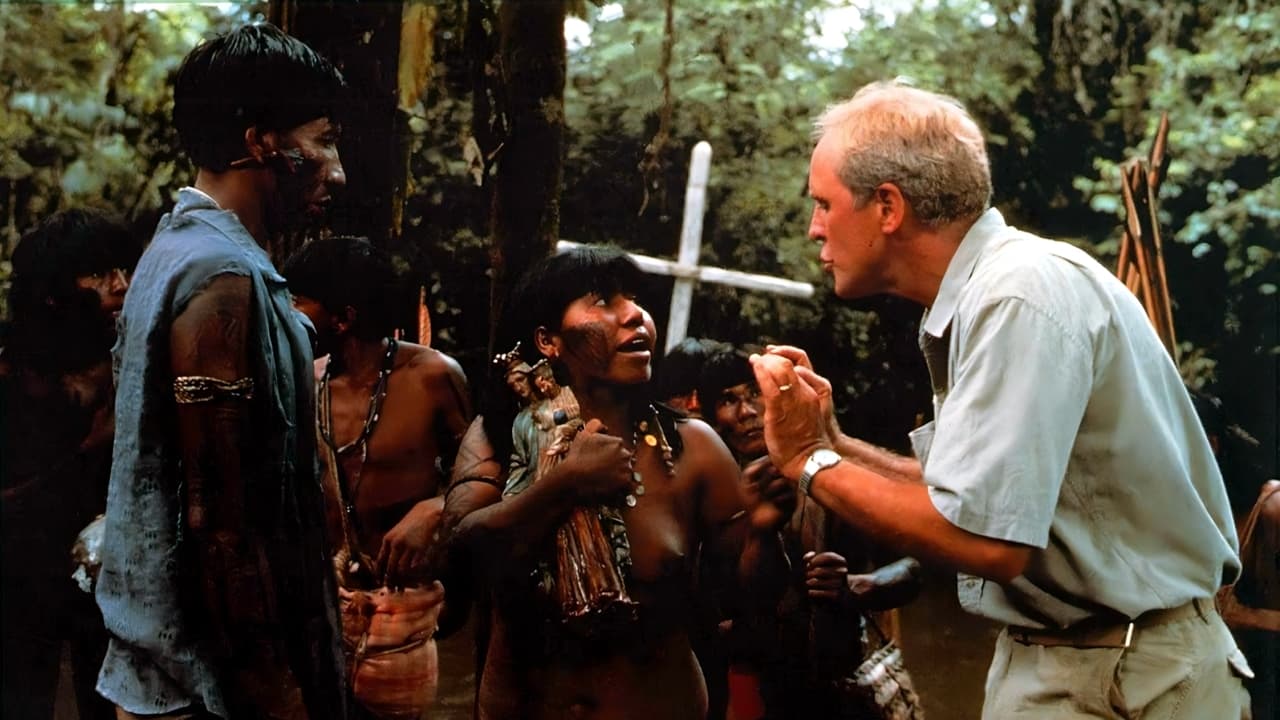

Intense, gripping, stylish and poignant
... View MoreIt's an amazing and heartbreaking story.
... View MoreIt's a movie as timely as it is provocative and amazingly, for much of its running time, it is weirdly funny.
... View MoreStory: It's very simple but honestly that is fine.
... View MoreThis is not your typical adventure movie. This is a marvelous drama about culture clash - the clash of civilization and nature. I will not spent time to describe everything here, because words are really not enough. Despite not being popular, this movie is among my favorites and a must-see I could say. Very very good story, amazing views, especially the aerial ones, wonderful music and great acting.Speaking of acting, everybody love Tom Berenger and Daryl Hannah, but I must give credit also to Aidan Quinn and especially Kathy Bates, whose acting in this movie I like the most.I am not aware who are the people playing the native tribes, but they deserve a great credit for good acting too.This movie is greatly underrated, so do not consider IMDb or another score and just go and see it.
... View MoreLed by the director of "Kiss of the Spider Woman" and starring an amazing cast, this epic of three hours goes to show something that some of us might have seen in another film. Better and shorter than "At Play in the Fields of the Lord", the awarded "The Mission" (1986) presented the conflict between Portuguese and Spanish explorers in the 18th Century for the control of lands in the Brazil-Paraguay areas and in the middle of all that there was the Catholic Church trying to convert the Indians who lived there, trying to save their innocent souls from hell. And there was also the ones who saw in these natives a way to explore their hard work, and many of these natives were killed simply because they refused to be part of this; they had their lifestyle and didn't need to contribute for the so-called progress brought by the white man. Babenco takes this premise and brings into the 20th Century; so, instead of European nations taking over the land there's corrupt businessmen who want to kill the natives to take their gold and the rubber that's present on the land. Their salvation is on the hands of American missionaries (John Lithgow, Daryl Hannah, Kathy Bates and Aidan Quinn) who are teaching the Catholicism to them; and a former mercenary (Tom Berenger) who is Half-Indian, and he decides to join the natives after being accepted by them as being a god that came out of the sky (after an incident where he jumped from his plane using a parachute).And do you think those missionaries learned the lesson about letting the Indians preserve their own culture instead of "planting" new concepts on their heads? Of course not! What makes this epic different from Roland Joffe's classic is not only the period both stories occur but also that in this film we have time to hear what the Indians have to say about the white man, that aspect was left out in 1986 film which caused some controversial to the film. Here, the tribe that was supposed to be destroyed by Berenger's character is completely opposed to relations with the missionaries, believing they bring diseases to their community (and they're right). However, if giving voice to the Indians was a good aspect that diverged from "The Mission" this film couldn't touch its greatness in terms of quality of the performances and the story, that goes overlong, with too much time to present to us how different the cultures are, that sort of thing made for the audience to relate with the missionary couple (Bates and Quinn) and their son (Niilo Kivirinta) trying to get used to the jungle. Joffé's film is a great History lesson; this one is a pure adventure.There's a sense that the film tries to please its audience so much but it doesn't work all so well with some spectacular sequences, the good music by Zbigniew Preisner and the stellar cast. The latter only having good performances from Tom Waits and the always excellent Nelson Xavier who plays a priest who understands better than anyone what happens in this danger zone. The famous stars from this, well, they act too much and you can't trust them while playing those characters. There's times when you see their faces and you'll go "Oh, it's that guy from that other movie!" They simply don't disappear into the character.I enjoyed this film because of its story and its message of learn to respect other cultures that aren't evolved like ours. Not to mention that even in its three hours the movie never gets boring, never gets uninteresting and actually goes quite fast.Problematic, flawed and not much full or rich in its content, "At Play in the Fields of the Lord" even with all these troubles, manages to be a visually beautiful film that deserves some recognition. Watch it more for its entertainment purposes than for its political and artistic contexts. 9/10
... View MoreI purchased the video of this film after it passed through the theatres so fast I was unable to see it. I had read and reread Peter Matthiessen's award winning book and still gift it to friends and family. The film remained true to the novel. No film can truly portray in three or even in five hours all the complexities that a good writer can express. This film did however do an exceptional job for the time it had.Some have said this film is anti Protestant, or just anti missionary. That is just too simplistic and misleading a label for this story. There is far more to digest than those labels could ever suggest. Here is the deliberate forced movement or destruction of a tribe to gain gold mining opportunities. This is happening with local government officials looking the other way ignoring current federal obligations to the native population. There is a built in irony that Moon (Tom Berenger) is part Cheyenne Indian. The current South Dakota reservations came about by our government reneging on deals in order to get access to gold in the Black Hills. The result was an ecological and cultural disaster for the Sioux nation.This film was as about the symbiosis of culture and environment. Missionaries in Micronesia told the islanders in Yap that taboos on fishing were just superstition. An island bio-system that could once support 10,000 people can now not even support 1, 000. Missionaries tell South American tribes that their occasional drug inspired journeys are pure evil. There are ways these ancient cultural traditions can be kept without any threat to Christian doctrine. Instead, especially for western protestant missionaries, conversion is often more about cultural than religious conversion. This results in the ultimate economic and ecological destruction that follows.Everyone should see this film, and better yet read the incredible book that inspired it.
... View MoreI was disappointed in this movie because it misrepresents evangelical missionaries. In the bar-scene Tom Berenger taunts the "visiting" new missionary who responds that he is working for his salvation every day. No evangelical would say that. Protestants abhor the idea of a "works-salvation" and blame Roman Catholics with that concept. With his linguistic training, he probably had a minimum of three years of undergraduate training in a religious institution plus one or two years linguistic training. His theology would not have caused him to answer as he did. Admittedly he might not have excelled in apologetics because a lot of evangelicals had an isolation approach where they were not taught how to respond to ridicule or opposing views.His wife "Hazel" does not seem to favor the idea of going to the mission field and has difficulty adjusting. Mission directors don't send couples to the field where one is well trained and the other is not. "Hazel" would have had to have at least undergraduate training in a Bible college.Furthermore, they would have had a few months orientation at the field headquarters so that they would know what to expect.Their child would not have stayed with them. He would have been sent to a "boarding school" (probably Faith Academy in Quito Ecuador).While making "rice Christians" was common in Africa and Asia, it was not practiced in South America -- esp. Brazil. Even the "mother hubbard" actions of putting clothing on the naked native women was not practiced in South America. It is true that it was done in Africa and South-Sea islands.Daryl Hannah's ambivalent faith (i.e., switching from Protestant to Catholic) is not believable. The Catholics taught a synchronism and were far more aggressive than the evangelical protestants. Her nude scene was also contrary to her training. She would have gone swimming with a swim suit. She knew there were natives in the area.I doubt if the Niaruna tribe would have accepted someone who parachuted into their village. When missionaries first flew into the West coast of South America, they were met by the Auca Indians who slaughtered the missionaries because they thought they were devils from the skies. I rather imagine this new tribe would have done the same especially since they fired arrows at the airplane upon its first "failed" bombing attempt. These tribes did not readily accept someone from another tribe (unless they intend to deceive them). So Berenger (posing as a "fellow Indian" -- Cheyenne) would not have been accepted.Berenger infects the Niaruna tribe with the flu that kills them? I doubt it. Why not choose smallpox, dysentery, cholera, typhoid, etc.?Missionaries were not trying to civilize these Brazilian tribes as a previous poster suggested. They were trying to convert them and translate the Bible into their native language.It is patently obvious that the script was written by a Roman Catholic rather than a Protestant. I doubt if Evangelical missionaries were even consulted in the research for the script.The story line is interesting, but it fails in the facts.
... View More